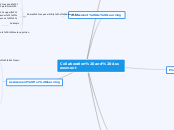Collaboration and Assessment
assessment for learning
May involve the TL and classroom teacher getting a sense of what it will be like to work together on this unit/theme/lesson
Clarifying any potential confusion re: content, goals, assessment, etc. ahead of time
developing appreciation for one another's expertise
Readiness to explore the subject of the lesson/unit
Experience
Attitude
Prior Knowledge
Who does the assessment for learning?
Can effective assessment for learning be designed by the TL who in not familiar with all the students? Can it be designed by the classroom teacher who may not be knowledgeable about all the aspects of the lesson? Need to collaborate.
This may be a good starting point to define roles and responsibilities in the collaborative teaching relationship.
Assessment for learning informs development of lesson and unit. TL needs it to develop the lesson, but usually it is part of a unit planner and delivered by the classroom teacher.
Need for communication with the classroom teacher
information about learning styles and needs in the classroom
Assessment As Learning
Shared responsibitlity of assessing
Students: metacognition
Subtopic
Classroom teacher: how will the learning that is happening now affect the future learning in the unit? What needs to be changed or supplemented? What supports will be needed?
TL: How can I best support this particular classroom teacher? Connecting points, differences, complementary areas
TL: how can I best respond to the needs of these particular students?
TL: what is working? what is not
Potential opportunities to allow the students to see the authenticity of their learning/key understandings/ task
Explore global opportunities - connect with schools, organizations, etc. in other parts of the world
Connect to the community: organizations, charities, potential employers, people in need, families - demonstrate authentic needs and ways to respond to them
Present sample projects employing key understandings
Stimulate curiousity
Challenges
Teachers/students/parents attached to traditional ways of assessment and expecting "bird" projects
Difficulties with reaching out and connecting to the community
Communication within the school community
Productive Mindset
How can the learning/ key understanding/ product be shared with others, and for what purpose - SO WHAT?
Opportunities for leadership, entrepreneurship, global thinking and initiatives, social justice
Where can this learning, key understandings, product, be used in the students' lives, school community, outside community, globally - SO WHAT?
Reinforce extending one's thinking, questioning, creativity, collaboration, enterprenurship
Assessment open to choices and interpretations, as long as key understandings are demonstrated
Create stimulations to provoke students to ask higher order questions
Ask higher order questions
Students need to make/create/synthesize something
Assessmnent of Learning
Backwards design: desired outcomes predetermined
Assessment in all categories
communication
application
thinking/inquiry
knowledge/understanding
Authentic task
implementing, utilizing, extending and building on the 21st century learning
Allows the students to fully see and appreciate what they have learned and how they can share it with others
Age/developmentally/learning style appropriate
Implementing social and emotional learning
hands on - activating creativity, allowing students to make something and create a concrete realization of what they have learned and accomplished
activating critical thinking
tapping into, activating and extending current knowledge and understanding
Relevant to students' lives and ongoing learning
Both (or all) involved sharing an understanding of success criteria
important to communicate in a situation where TL designs the assessment and CT does the assessing
criteria very clear to ensure consistency
Input needed from the classroom teacher
prior knowledge and experiences
learning needs in the classroom
learning styles in the classroom

